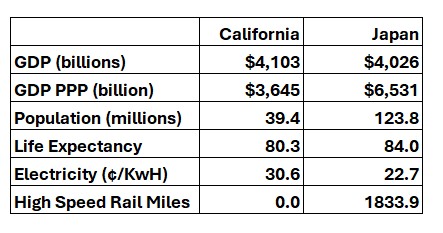Is California’s Economy Really Larger Than Japan’s?
In 2024, California’s Gross Domestic Product surpassed that of Japan. The Golden State’s GDP is now higher than those of all but three countries: the United States, China, and Germany. Governor Newsom’s office was quick to trumpet the statistical development, declaring California “the 4th largest economy in the world.”
But is this true in any meaningful sense? To answer this question, let us examine the statistics in the accompanying table.

Although its population is dropping, Japan still had three times as many people as California in 2024. For California’s economy to be larger, Japan’s residents would have to be three times poorer.
Having recently visited Japan, I can say that it certainly did not look three times poorer. The country has better infrastructure than we do, including over 1800 miles of high-speed rail compared to zero here. There are also plenty of upscale consumer amenities including fancy malls and high-end designer shops.
Japan also appears to have better healthcare given the 3.7-year gap in our respective life expectancies,
So why do the GDP numbers put California ahead? A big part of the reason is California’s high price of everything. For example, in December 2024, average residential electricity costs were 35% higher in California than Japan.
Economists devised a method for standardizing GDP statistics across geographies. They apply a purchasing power adjustment. Once GDP is rescaled to achieve “purchasing power parity” (PPP), we see that Japan’s 2024 GDP was 79% higher than ours. That still means on a per capita basis, the average Californian is much richer than the average Japanese, but the gap falls from 3:1 to less than 2:1.
Also, according to statistics compiled by the Center for Jobs and the Economy, California’s 2024 GDP rank falls from fourth to eleventh when prices are factored in.
That is still impressive, but nothing that Governor Newsom can claim credit for. California’s economic success traces back to the Gold Rush. Among those who made their fortune from that event was Leland Stanford, who went on to found Stanford University. In the early 20th Century, Stanford graduates began creating the electric, semiconductor, software, and internet firms that power the Silicon Valley and greater Bay Area economies today. Today, five of the ten highest market capitalization companies are based in Silicon Valley. It would have been six, but Newsom drove Tesla out of the state.
Visionaries of the past also created California’s other powerful industries including entertainment and theme parks in Southern California, Central Valley agriculture, and wine growing in Napa County and beyond. These industries are now under pressure often because of ill-advised state policies.
Readers should keep all of this in mind for later this decade when California will likely pass Germany to become “the world’s third largest economy.” That too will be a mirage resulting from the high cost of living here, and these elevated costs are something the current Governor can take credit for.
Marc Joffe is a Visiting Fellow at California Policy Center and President of the Contra Costa Taxpayers Association.
